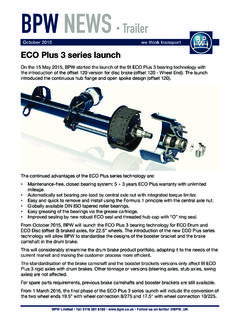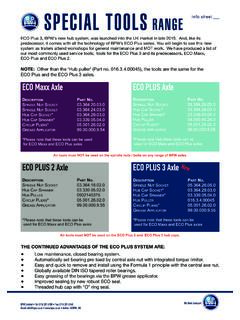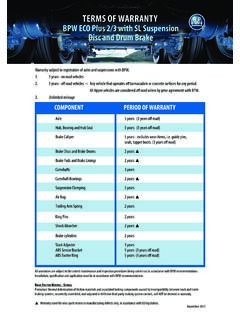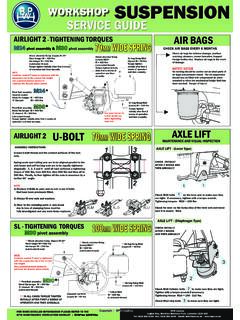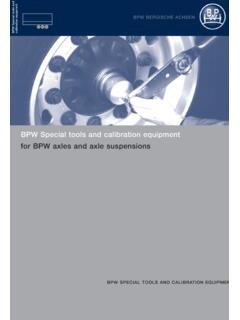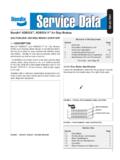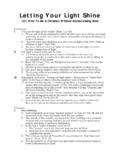Transcription of Wear and damage characteristics on friction …
1 wear and damage characteristics on friction brakes- Disc brake -BPW THE QUALITY FACTOR3(3901801e) - Disc brake -OverviewDust coverBrake discBrakecylinderBrakepadsBrakecalliper4 (3901801e) wear and damage characteristics on friction brakesForewordThe purpose of this brake engineering publication for disc braked commercial vehicles is to explain wheelbrakes. It is aimed at vehicle manufacturers, haulage contractors, workshops, testing centres, drivers and, in general,anyone interested in commercial vehicles. The document serves as a guide in the assessment of possible cases of wear and damage . The objective is toprovide decision aids which can be used to distinguish between normal wear and misuse of brakes.
2 Typical wear and damage profiles to disc brakes and their components are summarised in this catalogue. Thefindings, causes and repercussions of each case of damage are explained in addition, specific suggestions for remedial action are of authorsMr. M. PehleMr. Dr. B. MeurerMr. U. Dabringhausen Mr. R. Eskes Mr. J. Flick Mr. K. R. LangMr. H. PaechMr. S. PielenMr. M. PilzMrs. J. Schr dlerMr. Dr. J. F. Franke5(3901801e) - Disc brake -ContentsIntroduction6 Operation / construction7 Comparison between disc and drum brakes8 Inspection and maintenanceAssessment of wear9 damage profiles and states of wearThermal destruction of the brake 10 Extreme contamination of the brake 11 Edge contact between backplate and brake disc 12 Slanting wear due to off road use 13 Uneven wear due to sticking brake callipers14 Severe corrosion in the brake calliper 15 Overheated boots 16 Edge pitting on the pad17 Crack formation on a pad 18 Pad at wear limit19 Disregarding the pad wear limit 20 Thermally overloaded brake disc with crack 21 Thermally overloaded brake disc due to
3 Disregarding of pad wear limit 22 Pad impression on the brake disc 23 Corrosion in the brake cylinder 24 Leaking clamping band on the brake cylinder 25 List of keywords 266(3901801e) wear and damage characteristics on friction brakesIntroductionDuring recent years, the disc brake has benefited from remarkable progress in the commercial vehicle use of the disc brake in commercial vehicles started when the pneumatically operated version wasdemonstrated at the IAA 1996. Since then, the disc brake has been able to capture a considerable market sharefor heavy commercial vehicles in central Europe. This is primarily due to the safety aspect of the disc brake 'sfavourable fading properties: Even at high brake temperatures, it offers a consistently high level of braking the intervening period, all European tractor vehicle manufacturers have started equipping their vehicles withthis technology.
4 The disc brake has also made progress in Central Europe in the trailer area. In the early 1990s,BPW started to develop disc braked trailer axles and started series production in 1996 at the same time as thetractor vehicle (3901801e) - Disc brake -Operation / constructionThe chart shows a typical pneumatically operated disc brake for trailers and the brake pedal is pressed, the push rod (1) of the brake cylinder presses against the lever (2) of the brakecalliper. The roller (3) mounted eccentrically in the brake transfers the force onto the bridge (4). The clampingforce acts on the internal brake pad (6) via the threaded tubes and tappets (5). As a result, the brake pad (6) isforced against the brake disc.
5 The reaction force which now arises on the calliper (8) is transferred to theopposite brake pad (6) by means of the sliding carrier, so that the opposite pad is also pressed against the brakedisc with the same force. When the brake pressure is reduced, the spring force returns the bridge, the threadedtubes (4) and lever (2) to their original discThreaded tubeswith tappetsBrake padsBrake calliperPush rodLeverRollerBridge123456878(3901801e) wear and damage characteristics on friction brakesComparison between disc and drum brakesThe advantages of disc brakes concern safety. Geometrical advantages mean that the braking effort is onlyreduced slightly as temperatures rise (low fading).
6 This is because of the flat contact surface between the brakedisc and the brake pads, which only changes to a slight extent even at relatively high temperatures. Furthermore,the thermal expansion of the brake disc and the brake pads tends to reduce the required brake cylinder operation, disc brakes become significantly hotter than drum brakes with similar performance data. Thismeans the components of the disc brake are subject to significantly higher thermal stress. Dealing with thesehigher temperatures was always a main focus of material brake technology was developed further at BPW's initiative. The wear and crack resistance of the brakediscs and pads has been improved.
7 This means modern disc brakes can be operated in comparatively highertemperature ranges, and achieve long service lives at the same with more exacting requirements in terms of brake robustness will continue to be served with drumbrakes to an overwhelming extent. Their enclosed construction method means they are largely protected againstmoisture and dirt. The disc brake has also undergone further development in this area: The BPW Disc Protectoris a cover plate that protects the disc brake against coarse dirt during operation. The cavity cover has a similareffect. The less dirt that can get onto the disc, the more reduced and even the wear on the brake pads will tangential screw connection has made the attachment of the brake calliper to the axle significantly morestraightforward in terms of servicing.
8 To this end, the number of bolts has been reduced and it has also beenmade possible to reach them with spite of these improvements, incorrect operation or activation problems with incorrect matching between thetractor and trailer can lead to damage to the brake components. This document presents and explains various examples of damage and wear conditions on disc brakes, theircauses, effects and possible remedial explanations and information are available in the BPW commercial vehicle catalogue and thecorresponding workshop and maintenanceIn order to maintain the operating and road safety of the vehicle, the maintenance work specified by the vehicleor component manufacturer must be carried out at the intervals indicated.
9 During this, particular attention is tobe paid to the condition of the braking components should always be maintained in accordance with the information contained in the relevantworkshop work must be carried out in specialist workshops or on the vehicle owner's premises by trainedexperts in suitably equipped should only be renewed by genuine components, as even tested and cleared generic products candisplay undesired effects when they interact with genuine components. In individual cases, using genericproducts can result in undesired and very costly (3901801e) - Disc brake -Assessment of wearPads and brake discs are wearing parts and must be subjected to a visual inspection at regular that have reached their wear limit must be renewed.
10 This is the only way to guarantee that thebrake has sufficient safety reserves for emergency braking and braking in dangerous situations. wear limits of the pad and brake disc for and brakesmax. x mmaADCBmax. mm30 mm2 mm45 mm37 mmwearing edge4 mmWear status of the brake discThe brake disc must be examined regularly to check itsremaining thickness and any possible damage on thebraking surface. The permitted remaining thickness ofthe brake disc must not be below the minimum value inany area of the friction ring. Net like heat cracking (A),radial cracks up to mm width and depth (B) andunevennesses in the braking surface less than mm(C) are permitted.

